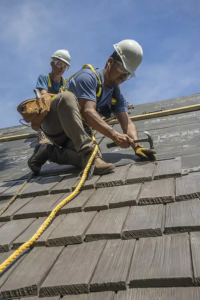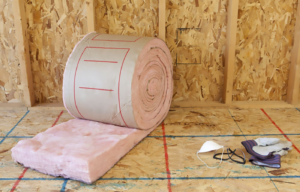Air conditioning is more than just a luxury; it improves your mental health, protects valuable electronics, helps you sleep better and adds value to your home. Choosing the right AC system involves understanding your cooling needs and energy efficiency goals.
The compressor raises the pressure and temperature of refrigerant gas before it flows into a condenser coil. Heat is rejected from the coil, and the refrigerant gas turns back into a liquid. Click the https://stahlmanac.com/ to learn more.

In its most basic form, air conditioning cools a room or building by reducing the temperature. Air conditioning does this by transferring heat through thermal radiation, convection or conduction. It also reduces moisture content. This helps reduce odors and prevent mold growth and other humidity problems.
The Energy Department sets appliance standards that help make air conditioners more efficient. We also fund research to improve the technology. For example, our Emerging Technologies program works on new compressors that are more energy-efficient and don’t use ozone-damaging hydrofluorocarbons (HFCs).
Cooling is achieved by using a heat exchanger. This exchange takes place over a period of time and requires a lot of mechanical energy. Cooling equipment consists of two components: the compressor and the evaporator. The evaporator coil absorbs heat from the air, which lowers its temperature, while the compressor increases its pressure and temperature. The hot compressed gas then travels to the condenser, where it gives off its heat and returns to the evaporator coil as a liquid. The cycle repeats.
It’s important to understand how cooling works, because it makes sense why you’d want your house or business to stay cool without wasting electricity. Aside from the obvious energy efficiency benefits, air conditioning can improve indoor climate quality by reducing pollutants such as dust particles and pet hair/dander. It can also minimize the irritants that cause asthma and allergies.
An early prototype of the modern air conditioner was developed by a Buffalo Forge Company engineer named Willis Carrier. He was trying to solve a humidity problem that caused magazine pages to warp and jam printing presses at Sackett-Wilhelms Lithographing and Publishing Company in Brooklyn, New York in 1902. He invented the first electrical air conditioning system by combining the principles of refrigeration with the technology of his day — an electric fan.
Today, there are a variety of air conditioners on the market, including central and ductless systems. Ductless systems offer flexibility for homeowners and businesses by providing cooling for individual rooms or spaces. They can be portable or fixed units. Portable air conditioners are usually hose systems that vent to the outside through a single hose or multiple hoses. Fixed units draw and expel air through a series of ducts that distribute the cooled air throughout a space.
Dehumidifying
Aside from making rooms feel stuffy and stale, high humidity can actually cause problems in your home. Humidity can rot wood and furniture, promote the growth of mold and mildew, make it hard for your clothes to dry, and lead to skin irritability and allergies. Fortunately, you can control humidity with a dehumidifier or dehumidification system, which removes excess moisture from the air.
In general, two types of dehumidification systems are available: mechanical and chemical. Mechanical dehumidifiers use compression refrigeration to cool the air and lower its moisture content by vaporization of the water in the air. This type of dehumidification is often used to protect sensitive electronic equipment, medical apparatus and museum specimens from humid environments.
Chemical dehumidification uses a chemical absorbent to reduce the moisture content of the air. Common solid desiccants such as zeolite and silica gel are commonly used for this purpose, but liquid desiccants are also available. This type of dehumidification has the advantage of not requiring cooling, but it can be costly. In addition to lowering the humidity in the air, these devices can remove odors from walls by using a process called “physisorption.” The molecules of odor are the same size as those of water vapor and can be removed together with the vapor.
Most portable dehumidifiers have a bucket or other receptacle to collect the water that condenses out of the air. This water is considered greywater and can be re-used for watering plants or gardens. However, before you recycle the water from your dehumidifier, be sure to check with your local environmental department for restrictions and regulations.
Whole-home dehumidifiers are designed to be much more powerful than portable models, and some are capable of removing up to 50 gallons of water from the air each day. They can also be installed in conjunction with your heating and cooling system to help regulate air temperature and improve comfort in the entire house. They can be configured to operate continuously or to run on demand. Depending on the model, some will even adjust their run time according to the relative humidity of the room.
Filtration
Filtration is a physical separation process, which separates solid particles from a mixture of fluid and solids. The solid particles are retained by a filter medium with a complex structure through which the fluid can pass. The fluid that passes through the medium is called filtrate. The process differs from sieving, where the separation is accomplished using a single perforated layer (e.g. a sieve). Oversize particles may form a cake layer on the filter surface or block the filter lattice, preventing the fluid phase from crossing the solid, which is known as blinding.
The simplest method of filtration uses gravity to filter a mixture. The mixture is poured over a solid that traps the solid while the liquid flows below it. The liquid that flows over the solid is the filtrate. Many physical, chemical and biological systems utilize filtration to remove solids from a fluid stream. For example, the kidneys filter blood to remove excess water and other waste products. Plants and animals also use a variety of filtration methods such as entrainment, phagocytosis and adsorption.
Air conditioning systems filter the air to reduce mold spores, dust mites and other contaminants in the air that can trigger allergies and asthma. They also recirculate and filter the indoor air to reduce the amount of outside pollution brought inside, such as vehicle exhaust from trucks and buses. In addition, HVAC systems typically use gasses such as Freon to cool the system, although this type of refrigerant is being phased out because it’s not environmentally friendly.
Energy Efficiency
Air conditioning is one of the biggest energy consumers in the home. As energy efficiency becomes more and more of a priority, many manufacturers are incorporating the latest technologies into their air conditioners to reduce their overall energy consumption and impact on the environment.
The most obvious way to improve your air conditioning’s energy efficiency is to replace it with an ENERGY STAR qualified AC unit. These units are designed to use less energy than standard models, saving you a significant amount on your utility bills. You can usually find the ENERGY STAR rating on the unit’s cabinet or in its user manual.
You can also improve your AC’s energy efficiency by lowering its operating temperature. Cooling your home just a few degrees lower than usual can cut your energy consumption by up to 3%.
Energy efficiency is also measured in terms of Seasonal Energy Efficiency Ratio (SEER) and Coefficient of Performance (COP). SEER ratings indicate how much cooling a specific unit provides for each kilowatt-hour of electricity it consumes. The higher the SEER rating, the more efficient the system.
While high SEER ratings are a good place to start when shopping for an air conditioning unit, it is important to remember that other factors play into how much energy your home will use, including its size and the number of people living in it. In addition, physical factors such as furniture placement and shading of windows can affect the amount of work your HVAC system has to do to keep your house at a comfortable temperature.
Another aspect of energy efficiency is reducing the amount of fossil fuels you use to power your heating and cooling system. When your HVAC systems are not operating at their highest efficiency, it means more carbon dioxide is released into the atmosphere. Energy-efficient ACs allow you to reduce your use of fossil fuels, contributing to a healthier climate and sustainable living.







